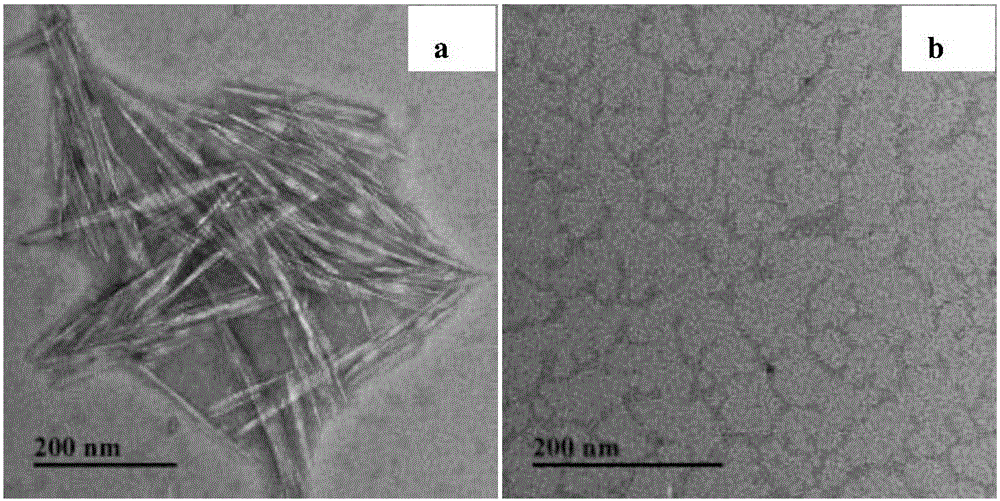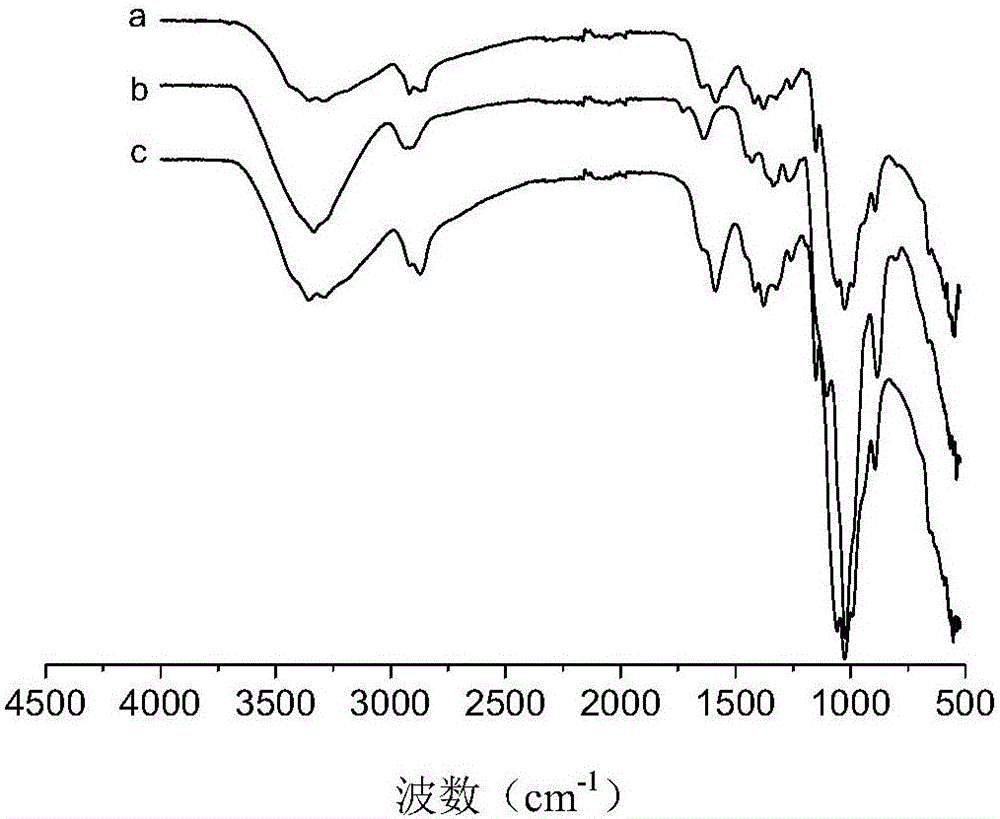Preparation method of dialdehyde cellulose cross-linked chitosan film
A technology of cross-linking chitosan and cellulose, which is applied in the field of preparation of dialdehyde cellulose cross-linked chitosan film, can solve the problems that there are no reports of dialdehyde cellulose cross-linked chitosan film, and achieve high mechanical The effect of strength, less pollution and simple preparation process
- Summary
- Abstract
- Description
- Claims
- Application Information
AI Technical Summary
Problems solved by technology
Method used
Image
Examples
Embodiment 1
[0022] (1) Add 1 part of microcrystalline cellulose to 20 parts of 64% (w / v) concentrated sulfuric acid, mechanically stir at 45°C and 600r / min for 1h, centrifuge at 10000r / min at high speed, and collect the upper layer of white CNC colloid After 3 days of dialysis, add 0.1N sodium hydroxide solution to adjust the pH of the colloid to 6.5;
[0023] (2) Add 6.3 parts of sodium periodate to the CNC colloid prepared in step (1), react at 45°C for 4 hours in the dark; add 3 parts of ethylene glycol to react for 1 hour and dialyze for 5 days to obtain dialdehyde cellulose aqueous solution;
[0024] (3) under room temperature, adopt 1% (v / w) acetic acid solution to prepare 1% (w / w) chitosan solution, 1 part of dialdehyde cellulose aqueous solution prepared by step (2) and 100 parts of 1% The chitosan solution was mixed, vacuum defoamed, cast in a polytetrafluoroethylene mold, and dried at room temperature to form a film.
Embodiment 2
[0026] (1) Add 1 part of microcrystalline cellulose to 20 parts of 64% (w / v) concentrated sulfuric acid, mechanically stir at 45°C and 600r / min for 1h, centrifuge at 10000r / min at high speed, and collect the upper layer of white CNC colloid After 3 days of dialysis, add 0.1N sodium hydroxide solution to adjust the pH of the colloid to 6.5;
[0027] (2) Add 6.3 parts of sodium periodate to the CNC colloid prepared in step (1), react at 45°C for 4 hours in the dark; add 3 parts of ethylene glycol to react for 1 hour and dialyze for 5 days to obtain dialdehyde cellulose aqueous solution;
[0028] (3) under room temperature, adopt 1% (v / w) acetic acid solution to prepare 1% (w / w) chitosan solution, the dialdehyde cellulose aqueous solution prepared by 3 parts of steps (2) and 100 parts of 1% chitosan solution The chitosan solution was mixed, vacuum defoamed, cast in a polytetrafluoroethylene mold, and dried at room temperature to form a film.
Embodiment 3
[0030] (1) Add 1 part of microcrystalline cellulose to 20 parts of 64% (w / v) concentrated sulfuric acid, mechanically stir at 45°C and 600r / min for 1h, centrifuge at 10000r / min at high speed, and collect the upper layer of white CNC colloid After 3 days of dialysis, add 0.1N sodium hydroxide solution to adjust the pH of the colloid to 6.5;
[0031] (2) Add 6.3 parts of sodium periodate to the CNC colloid prepared in step (1), react at 45°C for 4 hours in the dark; add 3 parts of ethylene glycol to react for 1 hour and dialyze for 5 days to obtain dialdehyde cellulose aqueous solution;
[0032] (3) under room temperature, adopt 1% (v / w) acetic acid solution to prepare 1% (w / w) chitosan solution, the dialdehyde cellulose aqueous solution prepared by 5 parts of steps (2) and 100 parts of 1% chitosan solution The chitosan solution was mixed, vacuum defoamed, cast in a polytetrafluoroethylene mold, and dried at room temperature to form a film.
PUM
 Login to View More
Login to View More Abstract
Description
Claims
Application Information
 Login to View More
Login to View More - R&D
- Intellectual Property
- Life Sciences
- Materials
- Tech Scout
- Unparalleled Data Quality
- Higher Quality Content
- 60% Fewer Hallucinations
Browse by: Latest US Patents, China's latest patents, Technical Efficacy Thesaurus, Application Domain, Technology Topic, Popular Technical Reports.
© 2025 PatSnap. All rights reserved.Legal|Privacy policy|Modern Slavery Act Transparency Statement|Sitemap|About US| Contact US: help@patsnap.com



